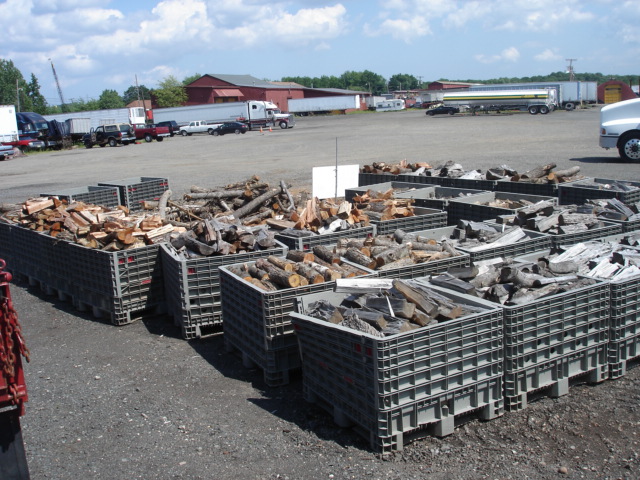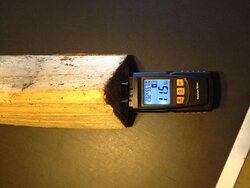I posted this yesterday but it got lost, so I'll ask again what does everyone look for in their seasoned wood? I tested mine and it was in the mid to high teens, it's been cut and split since latex winter early spring. And yes I did split the pieces I checked and took the reading on the internal side.
Moisture content
- Thread starter Brandon3r
- Start date
-
Active since 1995, Hearth.com is THE place on the internet for free information and advice about wood stoves, pellet stoves and other energy saving equipment.
We strive to provide opinions, articles, discussions and history related to Hearth Products and in a more general sense, energy issues.
We promote the EFFICIENT, RESPONSIBLE, CLEAN and SAFE use of all fuels, whether renewable or fossil.
You are using an out of date browser. It may not display this or other websites correctly.
You should upgrade or use an alternative browser.
You should upgrade or use an alternative browser.
- Status
- Not open for further replies.
Excavator
Feeling the Heat
mid teens is perfect in my opinion. Anything less than 22% is good in my opinion
Last month I brushed my liner and only got half quart of fine black like pepper dust
My rain cap gets dirty and I remove it and clean it every time I brush liner
Last month I brushed my liner and only got half quart of fine black like pepper dust
My rain cap gets dirty and I remove it and clean it every time I brush liner
Alan W
New Member
Do you regularly use your most ute meters? I don't have one and have always been curious .. But I'm not sure it would change much for me. I stack outside, and bring into a covered porch where I keep until I burn. If the wind blows hard it gets a little wet but I'd have no choice but to burn anyway. So I use the old timer approach based on experience.
Excavator
Feeling the Heat
I use the meter because I have way too much wood at my place of business and hard to keep tract of what is old and older lol
I just like to play with meter and test before I bring to my home

I just like to play with meter and test before I bring to my home
mark cline
Minister of Fire
Excavator , what does your sign say in front of your wood bins ? Something like "stay away or you will be shot, so don't even think about it"
I want to buy a moisture meter, and actually stopped at Lowes yesterday to do that but they were sold out. I'll keep checking. My oldest wood is about 8 months old, but I leave it in full sun all summer and recently moved it into a covered wood shed where it still gets plenty of a breeze. I think the dry winter breeze dries firewood as well as the hot summer sun does. I wish I could get a few years ahead but I just cant. The wood I just cut and might end up burning last in mid spring I split extra thin so it dries better. I don't get any water boiling out of the ends of my wood, and get great heat and a clean chimney so I think my method is good. I still want to buy a meter so I can experiment with different drying techniques. I still envy people who have 2 and 3 years of wood put up...I bust my butt just to get a years worth and as soon as I get a lttle ahead we have a never ending winter like last year so I end up burning the surplus.
It makes a huge difference in what type of wood you have, how small it is split and where it is stored. I've had lots of softer hardwood in smaller splits that are easily below 20% in one summer of drying. You can't get that with big splits of oak in the middle of your pile. I'm also splitting my butt trying to get ahead of the drying cycle after burning more than I counted on last winter.
Since I'm switching from a 15" split for my old VC to a 24" for my new Equinox, I know it will take more drying time for the longer splits. A LOT less work on the chainsaw and splitter though.
Since I'm switching from a 15" split for my old VC to a 24" for my new Equinox, I know it will take more drying time for the longer splits. A LOT less work on the chainsaw and splitter though.
I very rarely burn anything above 17%. For me, 9-14% is perfect. I can get a 6-7 hour burn at 450-550*F stovetop temps with just 4 small 16" sticks. Chimney creosote is always almost non-existant. Viewing glass stays very clean most of the winter and I only feel the need to clean it about 3 times over 4.5 months.
Alan W
New Member
Okay- so here is my dumb question. if wood is seasoned, but more damp- wouldn't you get a longer burn time? Yes I know less efficient, creosote, etc.. but you would end up with more coals in the Am for an easier start if you had 1 piece that was a bit wetter than the rest..??..
In order to get wood with more moisture content to burn as hot, you need to supply it more air in order to boil out and evaporate the H20. By trying to extended burn times using higher moisture content fuel, radiating heat transfer temperature is naturally lower. It is much more efficient to burn wood fuel by controlling the intake charge volume. Some wood burning stoves can not choke the air supply low enough to burn wood that is at 7-10% efficiently. Most EPA certified stoves are however. Burn times are only extended partially based on moisture content, and air intake management. The largest factor is how much fuel (wood) can be crammed into the combustion box. As with anything, YMMV. My Drolet 1.9cu ft EPA stove will burn a solid 6-7 hours at 450-550*F stove top temperatures when fully stoked. I can raise that time by another hour by almost closing the air control almost all the way however, stovetop temps drop down into the 300-350*F range which doesn't quite keep our 1900sq ft home to a stable 69-70* temperature when it's colder than 18-20*F outside.
Okay- so here is my dumb question. if wood is seasoned, but more damp- wouldn't you get a longer burn time? Yes I know less efficient, creosote, etc.. but you would end up with more coals in the Am for an easier start if you had 1 piece that was a bit wetter than the rest..??..
The short answer is no. The fire would require more air and devote most of its energy to taking care of burning your wet wood. The biggest difference would be less heat and large coals.
You "could" burn wet wood slowly but that would just be a mess you don't want.
Ricky8443
Burning Hunk
To some degree the answer is yes. Everybody always talks about moisture content this, moisture content that. Seasoning is the breaking down of wood cells, which makes the release of moisture possible. When you burn unseasoned wood, much of the energy is consumed trying to evaporate the water out of the millions of enclosed wood cells, which is extremely difficult and energy inefficient. However, slightly moist, seasoned wood will dry out very quickly in the stove, as the cells are already broken down, allowing for easier release of the moisture. The center of a hard wood will generally not get wet from rain because it is so dense, so the extended burn time from wet seasoned hardwood is only minimal.Okay- so here is my dumb question. if wood is seasoned, but more damp- wouldn't you get a longer burn time? Yes I know less efficient, creosote, etc.. but you would end up with more coals in the Am for an easier start if you had 1 piece that was a bit wetter than the rest..??..
Alan W
New Member
So will a moisture meter actually tell how seasoned the wood is or just hot wet it is - obviously on a fresh split??
ironworker
Burning Hunk
HotCoals
Minister of Fire
Probe it somewhere towards the center of the piece after you re split it.
11% is really good..what is it balsa wood..lol.
11% is really good..what is it balsa wood..lol.
I posted this yesterday but it got lost,
It didn't get lost, it got moved to the Wood Shed forum where it belongs, and still resides...same place this thread's going right now. Rick
tigger
Burning Hunk
Woody Stover
Minister of Fire
Maybe, but the best is summer wind. High temps get those molecules moving in the wood and work the moisture to the surface. If you can stumble across a couple of craigslist scores of some split and stacked wood, it'll get you that much closer to being ahead.I think the dry winter breeze dries firewood as well as the hot summer sun does
red oak
Minister of Fire
The short answer is no. The fire would require more air and devote most of its energy to taking care of burning your wet wood. The biggest difference would be less heat and large coals.
You "could" burn wet wood slowly but that would just be a mess you don't want.
Each piece of wood has a certain amount of heat (BTUs) in it. You can either use those BTUs to heat your home or to burn off moisture. I would choose to heat my home. For longer burn times, adjust the air control and use denser wood.
- Status
- Not open for further replies.
Similar threads
- Replies
- 8
- Views
- 1K
- Replies
- 58
- Views
- 6K


